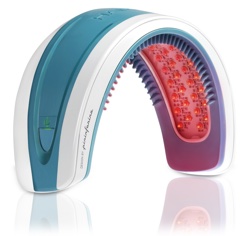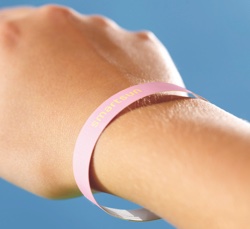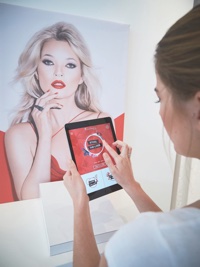Not many years ago electronic devices for skin and hair care were seen as the cutting edge of beauty innovation. Welcome to the brave new world of wearables and apps that are transforming the way consumers perceive beauty and the products they choose to use.
In less than a decade, smartphones have become common currency with over two billion global users recorded in 2016[1]. Connected consumers live digitally through their mobile devices, which are continually updated with new software enabling them to track all aspects of their lives. Now, mobile devices can be used to enhance beauty routines through app technology and by connecting to wearable devices.
“With technology becoming seamlessly integrated into day-to-day life, there is a growing dependency on tech solutions to allow consumers to better manage their lifestyles, and achieve optimum health and wellbeing. In this respect, the trust that consumers place in such tools is growing,” maintains Jamie Mills, an analyst at Canadean.
The trend for wearable trackers started with the revolutionary concept of a virtual trainer that allows consumers to monitor their fitness and calorie intake, popularised by the now ubiquitous Fitbit and Jawbone wristbands. According to Mintel, some people have engaged enthusiastically with such feedback tools, particularly the 16% of US consumers who have and/or are currently using a wearable health tracker.
The latest devices are evolving in line with changing consumer attitudes, particularly as the need for smarter lifestyles grows. Increasingly, there is a growing demand for integrated diagnostic approaches to monitor appearance-related concerns and health. Mills believes this represents an area of high potential for beauty brands to explore. “According to Canadean’s research, while only 10% of global consumers currently use digital tools to monitor or manage skin conditions, a further 40% say they would be interested in using them in future,” she says.
Monitoring skin health
The latest beauty wearables are opening up a whole new world to consumers. They can track, measure and monitor appearance and health in real time, empowering consumers to make better informed decisions on how to improve skin health and informing them as to whether or not the products and regimes they are following are effective. Although wearables for the beauty category is still in its infancy, there has been a rush to launch sun care and skin care monitoring devices. “In the case of measuring UV exposure, a diverse variety of skin sensors are available, ranging from prestige, high-end products like Violet Plus [which tracks UV exposure in real time, along with vitamin D production] to more inexpensive UV indicators, taking the form of stickers and wristbands,” comments Vivienne Rudd, Director of Innovation and Insight, Beauty & Personal Care at Mintel. For example, the Smartsun UV wristband is disposable after one day’s usage and measures the total amount of radiation during the whole day. Sensors detect both UVA and UVB, and change colour when the user needs to apply more sunscreen or get out of the sun. It can be used with any sunscreen and works on wet or dry skin.

The HairMax LaserBand stimulates hair growth
– a segment expecting more complex, compact devices
in future
L’Oréal’s La Roche-Posay My UV Patch is a stretchable electronic transparent adhesive, which contains photosensitive dyes that change colour when exposed to UV rays to indicate varying levels of sun exposure. Designed for use in conjunction with the smartphone app, the user can obtain real-time data on their level of UV exposure and feedback on their level of risk. So popular was the patch when it launched for summer 2016 that stocks ran out, and at the time of writing consumers could join a waiting list. Mintel notes an alternative to the My UV Patch, which has been developed by Queen’s University, Belfast, and is a plastic wristband that can be personalised to an individual’s skin tone. The wearable uses photoactive ink that disappears after sun exposure. “Innovations such as these definitely have economies on their side thanks to their appeal to budget-conscious consumers,” believes Rudd.
Another potentially groundbreaking development is the emergence of trackers that enable consumers to assess whether brands really do live up to their claims. “In particular, smartphone connected ones will allow them to monitor real-time patterns, such as skin hydration, pollution exposure and therefore ensure that they can address or prevent these issues going forward,” explains Mills, who sees the greatest potential among consumers who take an active and highly personalised approach to beauty and wellbeing. “This will also place brands under growing pressure to perform while making their products more accountable to consumers.” Canadean has documented Kickstarter-funded MAPO, a connected beauty mask from Wired Beauty, whose diagnostic skin moisture analysis programme is activated using a smartphone app. The wearable claims to deliver a warming effect to boost the efficacy of skin care products applied to the face and can also help to measure their efficacy.

Value options for UV monitoring,
such as the Smartsun wristbands, are
gaining traction
The emergence of wearable environmental trackers is likely to tap into consumer concerns over the effects of pollution and other environmental aggressors. One such device is Tzoa: a wearable environmental tracker that is smartphone connected and measures environmental factors such as air quality, temperature and UV exposure. The idea is that users can identify pollution hotspots to live healthier lives. However, the appeal of such devices would be enhanced if they were able to monitor the benefits delivered by skin care products. “Beauty care companies will make an even bigger impact when they can demonstrate their products’ anti-pollution efficacy,” maintains Rudd, who considers that creating social media buzz will be important in driving consumer engagement with anti-pollution beauty care. However, there may be obstacles. “Tracking changes in skin condition over time is technically more challenging and brands may struggle to link changes directly to their product’s efficacy,” she warns.
While skin care is likely to be the main area for innovation, there are further opportunities within hair care. For example, the HairMax LaserBand is a functional hair care device that is worn to stimulate hair growth using laser light to energise and revitalise the hair follicles. “In future, this is likely to become more complex and compact, with the ability to measure and track hair health, such as real-time UV exposure, dryness, levels of hydration or whether a hair care product has been effective or not,” predicts Mills.
Make-up apps

Rimmel make-up can be used to copy
any ‘look’ via the brand’s Get The Look app,
while Shiseido’s new game lets
people swap lippy ‘kiss monsters’
L’Oréal has been a pioneer in the development of the make-up app that enables consumers to see how products and shades look on their skin. Its Makeup Genius app uses an algorithm that can track all points on the face accurately so that the user can ‘try on’ a make-up product while making different facial expressions as if they were actually using the product. The added advantage in using such apps is that the consumer can sample as many products as she likes, something that can be messy and impractical to do at the counter. Another L’Oréal first has been the use of a Snapchat Lens for YSL Beauté Vernis À Lèvres Vinyl Cream Liquid Lipstick. Available for one day only, UK Snapchat users could try out four lipstick shades in real-time while looking at their camera. Burberry also recently used a sponsored Lens for the My Burberry Black fragrance launch.

In a world obsessed with celebrity-worship, a new app designed to ‘steal’ another person’s look is likely to have appeal, especially among digitally engaged millennial women, aged 18-35. Rimmel London Get the Look app works by pointing a smartphone at a friend, beauty ad or photo and recreating the look using matching Rimmel products.
The app is part of Coty’s ambition to grow Rimmel to become a billion-dollar brand and is designed to work with other beauty categories, including fragrance.
Much smartphone app technology for beauty is coming from Asia. Shiseido’s Misette (translated as ‘let me see’) allows users to share make-up tips and search by facial parts, rankings or tags. Meanwhile, Shiseido’s Rouge Rouge Kiss Me kissing game is an app tied to the new eponymous lip collection and enables two people to kiss through their phones, leaving lipstick marks as ‘kiss monsters’ appear on the screen.
Mirror technology is also gaining ground by opening up a whole new dimension through the ability to detect facial movement in real time. Korean brand Laneige was the first with its Beauty Mirror, which gives the user the impression they are actually applying make-up. They can then save and share the results on social media, such as Instagram, KakaoTalk, Facebook and Twitter. Crucially, the cosmetic items can be saved onto the phone and purchased directly from Laneige.
The future of beauty is… bioengineered
The fast-moving nature of technology means it is impossible to predict where the next trends will come from – for example, stick-on nails with in-built functionality. Lucie Davis, a London Central St Martins jewellery design graduate, has dreamt up Oyster-enabled acrylic nails that carry a chip, which allows the user to top-up their travel Oyster card and use it to check in and out of London tube stations. And it won’t stop there. “Subcutaneous microchips act as both wearables and a mobile payment scheme,” states Rudd. “They could be used to measure skin condition and buy the most relevant product.”
Watch out also for wearable biosensors which Rudd thinks will present a huge opportunity for beauty brands to connect with consumers and offer personalised product recommendations based on the data collected. An example is the Lumee biosensor that is attached to the surface of the skin or held in the hand and is fully integrated within the body’s tissue without any metal device or electronics. The biosensor is made from a bioengineered smart hydrogel similar to contact lens material and is linked to a light-emitting fluorescent molecule that signals the presence of oxygen, glucose or other biomarkers within the body. “Environmental monitoring [for UV or pollution] is likely to be the first to market for cosmetic biosensors,” predicts Rudd. “It has immediate consumer appeal and presents a lower hurdle for data collection and interpretation.”
Many of these new ideas may have started out as fanciful novelties, but increasingly beauty brands are recognising the potential of technology to enhance product experience, and engage more directly and effectively with consumers.
Author
Imogen Matthews
www.imogenmatthews.co.uk
Reference
1. Statista.




